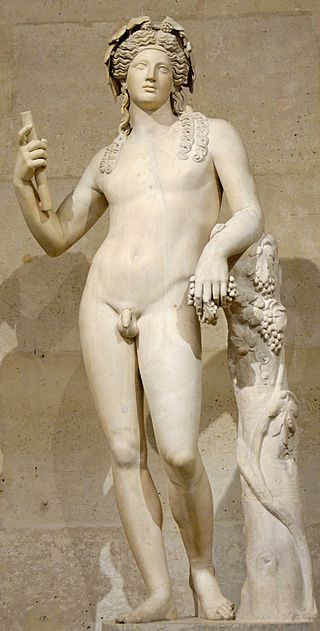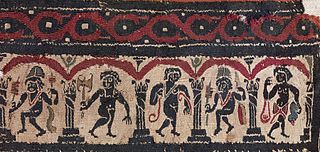Cult
Iacchus was one of the deities, along with Demeter and Kore (Persephone), worshipped as part of the Eleusinian Mysteries. [4] The late 1st-century BC geographer Strabo called him the ἀρχηγέτην ("leader-in-chief" or "founder") "of the mysteries". [5]
Statue, temple, and feast day

There was a statue of Iacchus kept in a temple at Athens. According to the 2nd-century AD geographer Pausanias, the statue held a torch and was by the Athenian sculptor Praxiteles. [6] A passage from Aristophanes' The Frogs (405 BC) suggests it wore a crown of myrtle. [7] According to Pausanias, the statue was kept in a temple of Demeter located near the Dipylon gate, the main entrance to ancient Athens. The temple was perhaps the one that Plutarch referred to as the "so called Iaccheion". [8] Nearby was the Pompeion, the building which was the assembly point for the procession celebrating the Eleusinian Mysteries. According to the 10th-century Byzantine encyclopedia the Suda , Iacchus was also the name of his "feast" day, presumably the day that Iacchus was carried to Eleusis as part of the Eleusinian procession. [9]
Eleusinian procession
Iacchus and his statue played an important part in the Eleusinian procession. [10] Plutarch referred to the procession as ἐξαγόντων Ἴακχον (“leading out Iacchus”). [11] On 19 Boedromion (probably), the statue of Iacchus was taken from its temple and carried as part of the procession of the participants in the Mysteries who walked from Athens to Eleusis, arriving on 20 Boedromion (corresponding to the 28th or 29 September). [12] Along the way, the participants in the procession would cry out the cultic exclamation, Iacche! [13]
There was a special official associated with Iacchus and his statue called the Ἰακχαγωγός ('leader/bearer of Iacchus'), whose function presumably was to carry or accompany the statue of Iacchus during the procession. [14] The Ἰακχαγωγός is listed as one of the Eleusinian officials receiving an endowment (c. 160–170 AD), [15] appears in a list of Eleusinian priests given by the 2nd-century AD Julius Pollux, [16] and had a reserved seat in the prohedria ("seats in front") of the Theater of Dionysus at Athens. [17] An incumbent of the office (126/7 AD) is mentioned on four dedications. [18]
A parody of the Eleusinian procession appears in Aristophanes' comedy The Frogs , set in Hades (the underworld). [19] There a chorus of dead mystics, singing and dancing in procession, chant their "hymn to Iacchus": "O Iacchus, Iacchus O!", and sing,
- Iacchus, here abiding in temples most reverend,
- Iacchus, O Iacchus,
- come to dance in this meadow;
- to your holy mystic bands
- Shake the leafy crown
- around your head, brimming
- with myrtle,
- Boldly stomp your feet in time
- to the wild fun-loving rite,
- with full share of the Graces, the holy dance, sacred
- to your mystics. [20]
and,
- Awake, for it has come tossing torches in hand,
- Iacchos, Oh Iacchos,
- the light-bringing star of our nocturnal rite.
- Now the meadow brightly burns
- Old men's knees start to sway.
- They shake away their pains
- and the long cycles of ancient years
- Through your holy rite.
- Beaming with your torch,
- lead forth to the flowering stretch of marsh
- the youth that makes your choruses, o blessed one! [21]
and,
- Now then
- Summon the god of the hour with your songs
- the partner of this dance of ours.
- Iacchus, honored by all, deviser of our festal song
- most sweet, follow us here
- to the goddess and show us how
- you travel a long road with ease.
- Iacchus, lover of the dance, lead me onward, [22]
The Lenaea
Iacchus also played a role in the Lenaia, the winter Athenian festival of Dionysus. [23] According to the scholiast on the Frogs of Aristophanes, participants at the Lenaia responded to the command to "Invoke the god" with the invocation, "Hail, Iacchos, son of Semele, thou giver of wealth." [24] According to the scholiast, the command to call on the god was proclaimed by the Daduchos, a high Eleusinian official [25]
At Delphi?
The name Iacchus—identified with Dionysus—was also possibly associated with cultic ritual at Delphi. [26] Sophocles' Antigone , referring to nocturnal rites occurring on Mount Parnassus above Delphi, contains the invocation:
O Leader of the chorus of the stars whose breath is fire, overseer of the chants in the night, son begotten of Zeus, appear, my king, with your attendant Thyiads, who in night-long frenzy dance and sing you as Iacchus the Giver! [27]













